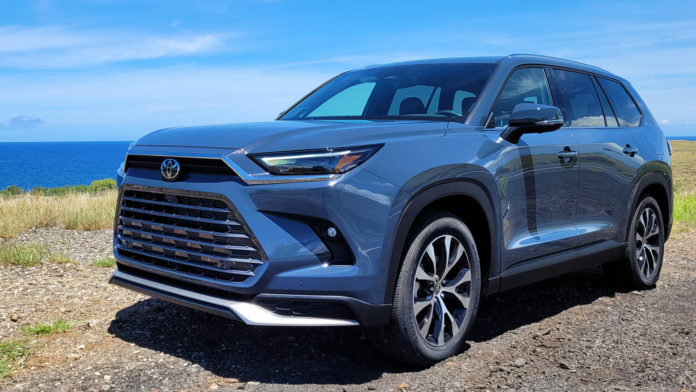The Highlander has been a hit for Toyota as the company has sold over 3.3 million units in the United States. That’s an impressive accomplishment, but crossovers have been growing in size and the Highlander’s third-row has become third-rate.
As we noted in 2019, when the latest generation was launched, “the third-row has always been the Highlander’s weak spot and it still offers just 27.7 inches (704 mm) of legroom.” As a result, we suggested limiting its use to “children and small adults in a pinch.”
Upgrading to the Sequoia doesn’t improve things much as the body-on-frame SUV offers between 28.1 and 33.7 inches (714 and 856 mm) of third-row legroom. On top of that, ride quality goes down the tubes while the price tag climbs to $59,865.
| FAST FACTS | |
|---|---|
| › MSRP: | $43,070* |
| › Output: | 243 – 362 HP |
| › 0-60 MPH: | As little as 6.3 seconds |
| › Fuel Economy: | Up to 36 mpg city / 32 mpg highway / 34 mpg combined |
| › On Sale: | July |
This effectively meant consumers looking for a crossover with an adult-friendly third-row had to cross Toyota off their list. Of course, they still had plenty of models to choose from including the Kia Telluride, Jeep Grand Cherokee L, and Volkswagen Atlas.
Toyota now wants a piece of the pie, so they’re launching the all-new Grand Highlander. It’s an interesting, but imperfect addition that will arrive at dealerships in July for $43,070.
A Highlander That’s Not A Highlander
advertisement scroll to continue
Pictures: Michael Gauthier/CarScoops
Despite wearing the Highlander name, the Grand Highlander is unique and has little in common with its smaller counterpart. The differences are immediately apparent as the larger of the two sports an edgy and distinctive design.
The Highlander’s soft curves and flowing surfaces have been replaced by a nearly vertical front fascia, which has a large grille and slender headlights. They’re joined by slab-sided bodywork, an expansive greenhouse, and metallic accents.
The design is handsome, but a bit generic and that situation will only be compounded when the crossover is parked next to the Mazda CX-90. That being said, it’s hard to fault the Grand Highlander’s styling and the entry-level XLE sports a power liftgate as well as 18-inch alloy wheels. The mid-level Limited ups the ante with LED fog lights, LED daytime running lights, and larger 20-inch wheels.
A Tale Of Two Cabins
Pictures: Michael Gauthier/CarScoops
Toyota interiors have had the warmth of an accountant’s Christmas card as of late, but things seem to be getting better. However, it’s still hit or miss and our two Platinum testers were radically different aside from equipment.
In the case of the Grand Highlander Platinum Hybrid Max, we were left feeling cold as the black plastic trim looked like something you’d find on a base model instead of a $58,125 range topper. Paired with a black interior, the cabin felt cheap and underwhelming as the only bits of visual interest were gloss black plastic and bronze accents.
The conventionally powered Grand Highlander Platinum was more impressive as it sported a two-tone design with faux wood trim and metallic accents. They add a much needed splash of color to the otherwise bland and plasticky cabin.
On the bright side, most of the plastic is of good quality and virtually every touchpoint is padded. However, Toyota continues to trail competitors as the Grand Highlander doesn’t feel as elegant or as stylish as rivals such as the Kia Telluride or Jeep Grand Cherokee L.
That being said, Toyota installs plenty of standard equipment as even the base XLE has heated power SofTex front seats and more USB ports than you can shake a stick at. Buyers will also find a 12.3-inch infotainment system, a 7-inch cluster display, and a wireless smartphone charger. It’s nice to see the latter come standard, but the charging pad doesn’t have a grippy surface and my phone spent more time sliding around than charging.
At the opposite end of the spectrum, our Platinum testers were loaded to the gills with virtually everything you could want in a mainstream crossover. Besides heated and ventilated seats in the first two rows, there’s a heated steering wheel, a panoramic moonroof, ambient lighting, and a 12.3-inch digital instrument cluster. However, this comes at a steep cost as the range-topping trim starts at $53,545 and climbs to $58,125 with the optional Hybrid Max powertrain.
Pricing aside, drivers will find spacious and comfortable front seats with just enough bolstering to keep them in place. Things are a little tighter in the second-row, but there’s plenty of head and legroom for adults. Customers can choose between a bench or second-row captain’s chairs, and the latter are separated by a center console that features two cup holders as well as three storage compartments.
A Third-Row That Doesn’t Feel Third-Class
Pictures: Michael Gauthier/CarScoops
The Grand Highlander’s raison d’être is its third-row and it’s a significant improvement over the one found in the Highlander. While it’s been a few years since I’ve crammed myself into the back of the smaller crossover, the Grand Highlander has 33.5 inches (851 mm) of third-row legroom. That’s 5.8 inches (147 mm) more than the Highlander Hybrid and 5.5 inches (140 mm) more than the conventionally powered model.
Those extra inches make a world of difference and the third-row is adult-friendly. That’s especially true if second-row occupants are willing to slide their seat forward. If they are, third-row legroom is actually kind of impressive and things don’t feel claustrophobic.
However, everything isn’t perfect as the third-row seat is hard and headroom is unsurprisingly limited. That being said, you can adjust the backrest angle to create a little extra room.
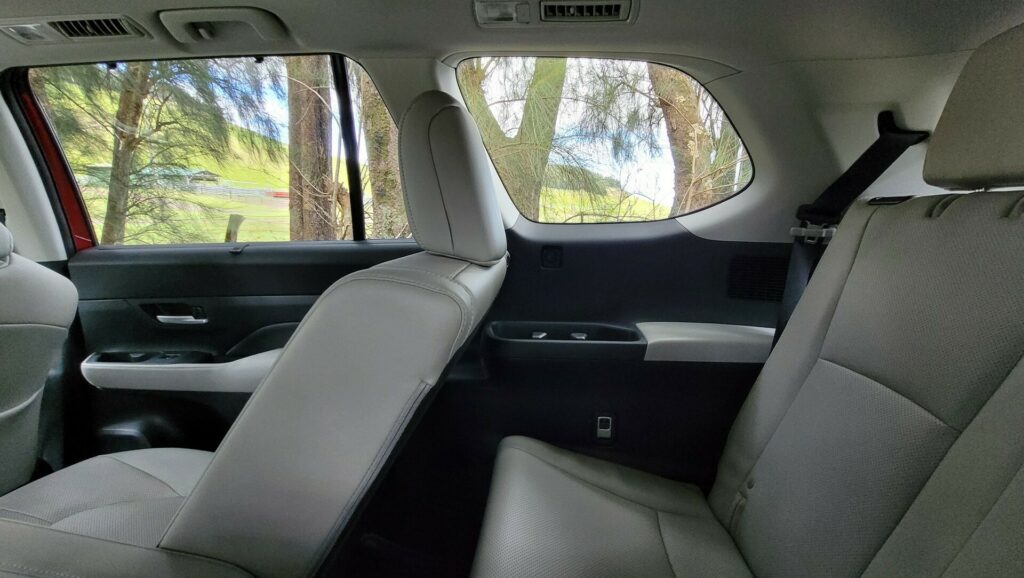
Entry is relatively easy and Toyota put a small step in the second-row to improve access. Once seated in the third-row, you’ll find practical storage trays and cup holders as well as USB charging ports. There are also ceiling-mounted vents and lights as well as seatbelt holders that keep them out of the way when not in use.
Getting out is another story as the release for the second-row is made out of some of the flimsiest plastic I’ve encountered. It’s a bit shocking as the rest of the controls for the second-row seat feel solid and substantial.
The situation is compounded by the amount of force required to get the second-row seat to release and slide forward. I was legitimately worried about breaking the handle off and I could easily see small children or elderly adults not having enough strength to operate the releases.
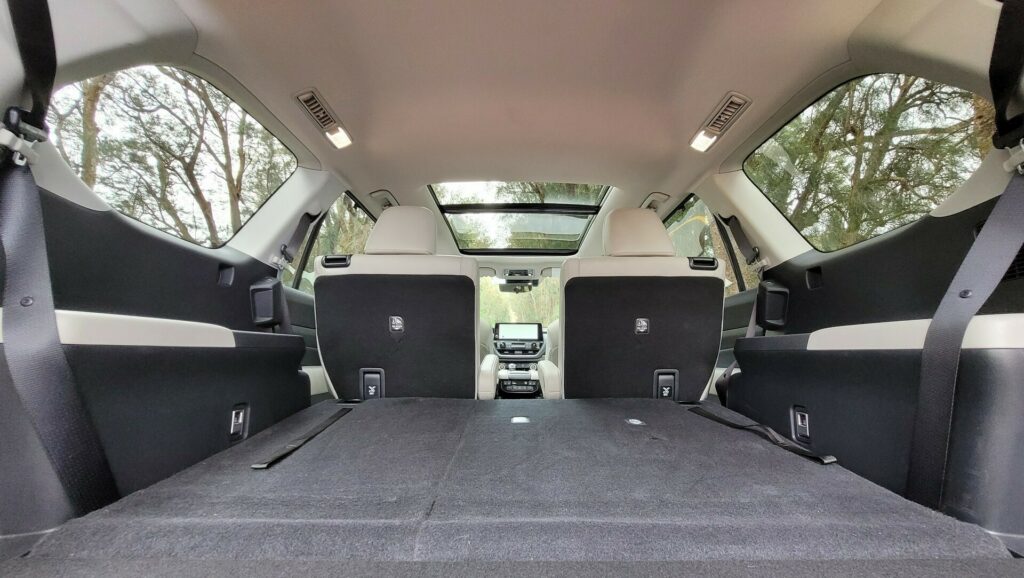
That isn’t the only problem as folding the third-row down is a headache. Since a power-folding third-row isn’t even available as an option, you’ll have to pull up on flimsy tabs while pushing the seat forward. This is easier said than done and I had better luck pulling the tab up, moving the seat backward, and then flipping it forward. When asked about the issue, Toyota officials said they were aware of it and will have the problem fixed by the time regular production begins.
Once you get the second- and third-rows folded down, you’ll find 97.5 cubic feet (2,761 liters) of storage space. That’s 13.2 cubic feet (374 liters) more than the standard Highlander and 12.9 cubic feet (365 liters) more than the Jeep Grand Cherokee L. The Grand Highlander also bests the Kia Telluride and Volkswagen Atlas, but comes up a little short of the Chevrolet Traverse.
If you have to balance cargo and people hauling, there’s 20.6 cubic feet (583 liters) of storage space behind the third-row. That increases to 57.9 cubic feet (1,640 liters) by folding the third-row down.
Three Engines Including A 362 HP Hybrid Max Option
Pictures: Michael Gauthier/CarScoops
While a number of three-row crossovers are only available with one engine, Toyota is offering three different options on the Grand Highlander. Kicking things off is a turbocharged 2.4-liter four-cylinder that produces 265 hp (198 kW / 269 PS) and 310 lb-ft (420 Nm) of torque. It’s connected to an eight-speed automatic transmission, which can be paired to either front or all-wheel drive.
Toyota expects 64% of buyers will opt for the turbocharged engine and it feels well-suited for the crossover. That being said, performance is nothing to write home about as key competitors offer more power and the crossover takes 7.5 seconds to hit 60 mph (96 km/h).
However, no one is buying a seven- or eight-seat crossover for its performance and the standard powertrain feels more than adequate. The eight-speed automatic delivers smooth shifts, although the engine doesn’t seem overly refined nor does it sound particularly good. Customers can also expect so-so fuel economy ratings of between 21 mpg city / 28 mpg highway / 24 mpg combined and 20 mpg city / 26 mpg highway / 22 mpg combined.
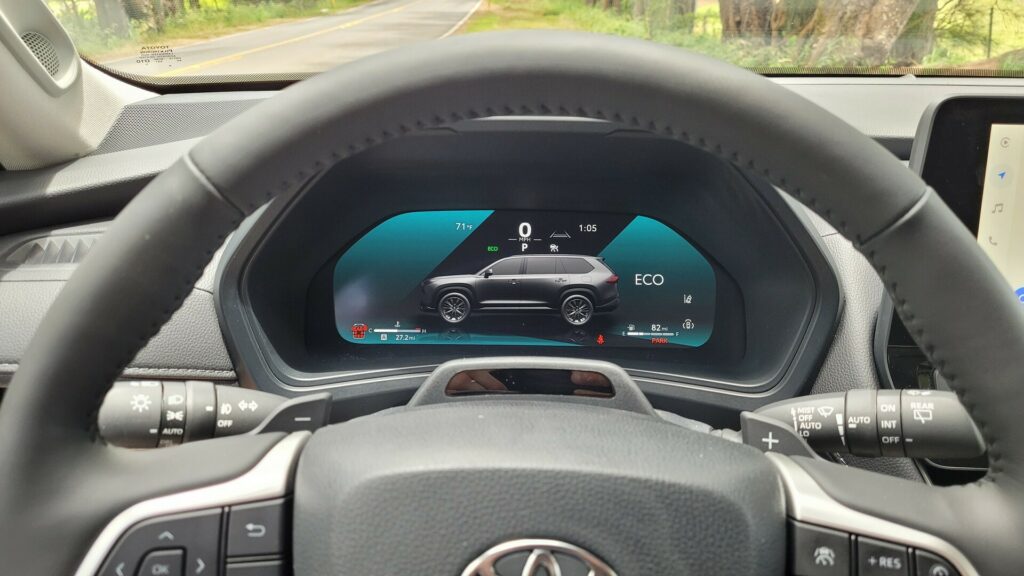
If fuel economy is cause for concern, you can spend an extra $1,600 and get a hybrid variant. It features a 2.5-liter four-cylinder engine, a small nickel metal hydride battery, an electric motor, and an electronically controlled continuously variable transmission. This gives the crossover a combined output of 245 hp (183 kW / 248 PS) as well as a slightly slower 0-60 mph (0-96 km/h) time of 7.8 seconds.
While we didn’t drive the Grand Highlander Hybrid, it’s similar to the Highlander Hybrid we drove a few years back. As a result, the driving experience should be similar to the conventionally powered model but more eco-focused.
Speaking of which, the hybrid variant is slated to return an impressive 36 mpg city, 32 mpg highway, and 34 mpg combined. Those are impressive numbers for a crossover this size and they easily surpass the Ford Explorer Hybrid, which has an EPA rating of up to 27 mpg city, 28 mpg highway, and 27 mpg combined.
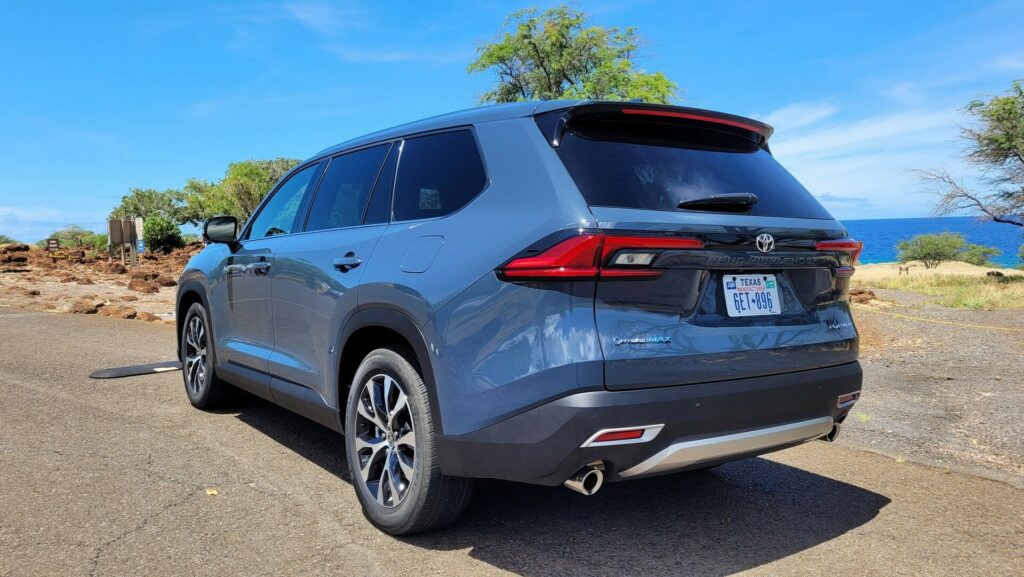
That brings us to the range-topping Hybrid Max, which combines performance and efficiency. It features a turbocharged 2.4-liter four-cylinder engine, a six-speed automatic transmission, a small battery, and a rear eAxle. The latter gives the crossover full-time all-wheel drive with front to rear power splits of between 70:30 and 20:80.
Besides being able to be rear-biased, the Hybrid Max powertrain is notable for producing 362 hp (270 kW / 367 PS) and 400 lb-ft (542 Nm) of torque. Those are some pretty impressive figures and they easily beat the 310 hp (231 kW / 314 PS) Chevrolet Traverse, 291 hp (217 kW / 295 PS) Kia Telluride, and 269 hp (201 kW / 273 PS) Volkswagen Atlas. It’s also worth noting the Hybrid Max has a mountain of torque, which is instantly available and allows for impressive off-the-line acceleration.
While the Hybrid Max powertrain is only expected to account for 6% of sales, it delivers impressive performance including a 0-60 mph (0-96 km/h) time of 6.3 seconds. The crossover also operates in relative silence and I was surprised by how loud the standard model seemed in comparison.
Unfortunately, it’s not all good news as you’ll have to spend at least $54,040 to get a Hybrid Max variant. Fuel economy also takes a hit as the model is expected to return 26 mpg city, 27 mpg highway, and 27 mpg combined, which effectively slots in between the standard model and the more mainstream hybrid.
A Comfortable Crossover That Knows How To Dance
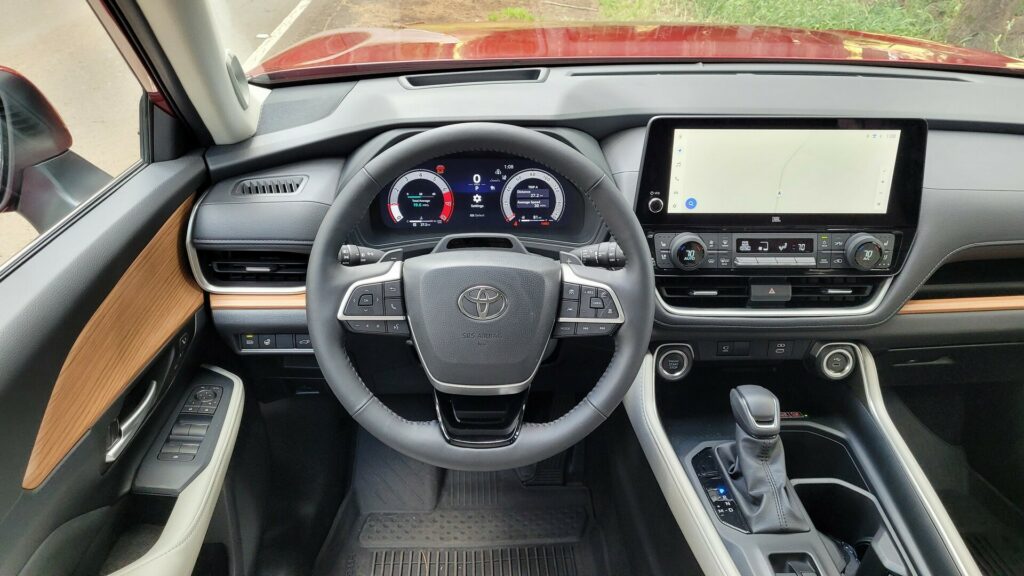
If you’re thinking why not just get a Sequoia, there are two very easy answers. The larger body-on-frame SUV starts at $59,865 and has a truck-like ride quality. The Grand Highlander, on the other hand, feels a million times better as the ride is silky smooth and body motions are well-controlled. It’s far more comfortable than its larger counterpart and is the one to get if you don’t need to tow more than 5,000 lbs (2,268 kg).
The comfortable ride can partially be chalked up to a modified version of the TNGA-K platform, which underpins everything from the Camry to the underrated but excellent Venza. It also forms the basis for other three-row models including the Highlander and Sienna.
While the independent front and multi-link rear suspension easily soak up minor road imperfections, the Grand Highlander isn’t too soft. When thrown into corners, the crossover responds with flat and stable handling that is largely devoid of body roll. The latter is good for a large crossover that measures 201.4 inches (5,116 mm) long.
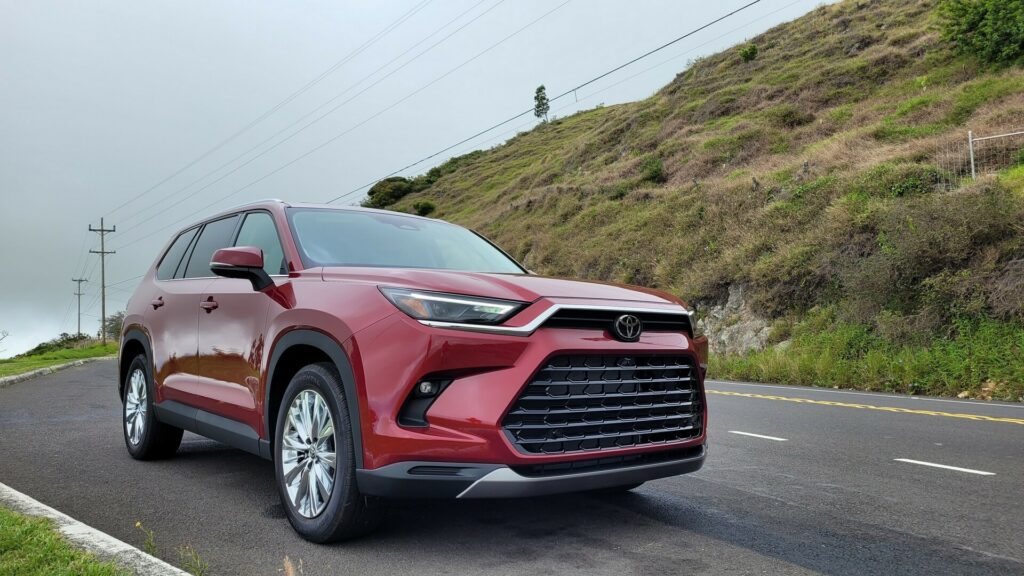
That being said, the Grand Highlander is a three-row crossover and it’s clearly focused on comfort. There’s a general laissez-faire attitude to things, but Sport mode makes a notable difference in improving steering feel and overall responsiveness.
Speaking of which, the brakes are up to the challenge of stopping the 4,300 to 4,920 lbs (1,950 to 2,232 kg) crossover. When called into action, 13.4 and 13.3 inch (340 and 338 mm) discs bring the Grand Highlander to a drama-free halt.
On the topic of safety, there are an assortment of driver assistance systems including a Pre-Collision System with Pedestrian Detection, Lane Departure Alert with Steering Assist, and Full-Speed Range Dynamic Radar Cruise Control. They’re joined by Lane Tracing Assist and Road Sign Assist.
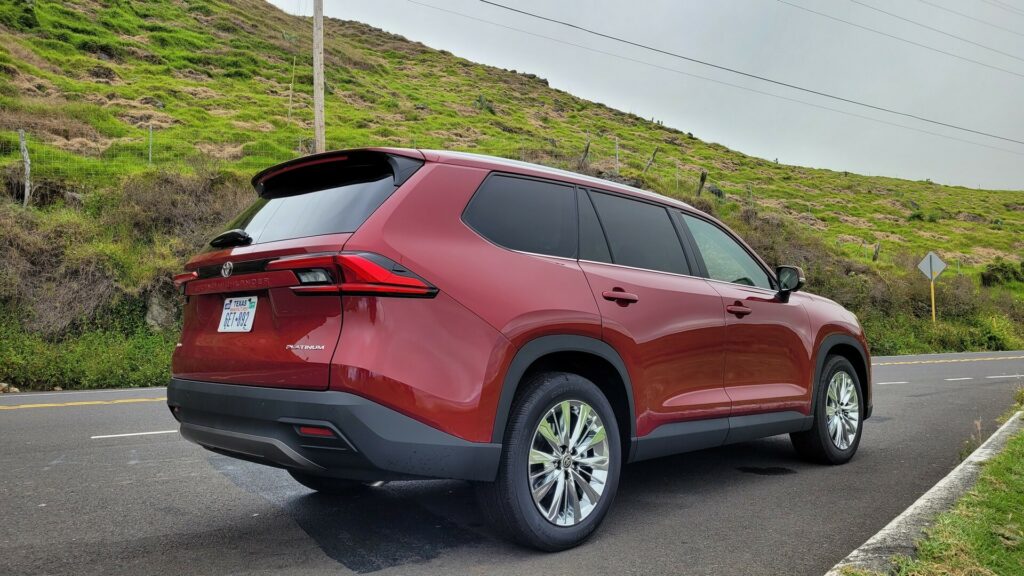
The crossover features Toyota Safety Sense 3.0 and it’s notable for having a new Proactive Driving Assist feature, which uses camera and radar sensors to provide “gentle” braking and steering support.
However, in our experience, the system is far too aggressive and constantly intervenes. It’s a bit like having a backseat driver, who grabs the steering wheel or hits the brakes at the slightest provocation. Needless to say, Proactive Driving Assist was quickly turned off.
The Grand Highlander also offers Traffic Jam Assist, which allows for hands-free driving at speeds under 25 mph (40 km/h). A camera monitors the driver to ensure they’re paying attention to the road ahead, while the vehicle controls steering, acceleration, and braking to make traffic jams less stressful.
Unfortunately, the feature is limited to the range-topping Platinum trim and it’s put behind a paywall as you’ll need an active Drive Connect subscription to use it. The latter is kind of understandable for BlueCruise or Super Cruise, but for Traffic Jam Assist it feels like a money grab.
A Solid And Worthy Addition To Toyota’s Lineup
If you’re in the market for a Toyota with a comfortable ride, a spacious third-row and available all-wheel drive, look no further than the Sienna. The minivan comes standard with a hybrid powertrain and starts at $36,885 which is $6,185 less than the Grand Highlander. It also has 5.2 inches (132 mm) of additional third-row legroom as well as a larger cargo capacity.
That being said, the Grand Highlander is a worthy alternative as it avoids the minivan stigma while looking reasonably good and providing a comfortable ride. The crossover is also spacious and offers an adult-friendly third-row.
On top of that, the Grand Highlander offers a good mix of performance and fuel efficiency. The standard turbocharged 2.4-liter four-cylinder is a good all-around choice, while the hybrid variant offers significant savings at the pump. The Hybrid Max builds on that with impressive performance as well as a comfortable and quiet ride. However, it carries a hefty $4,580 premium over the non-hybrid crossover.
There’s a lot to like about the Grand Highlander, but there are also some growing pains such as the third-row that is hard to fold down and the tricky second-row releases that make exiting challenging. Nevertheless, Toyota seems to be working to resolve some of the issues, so hopefully they’ll get things sorted out by the time July rolls around.

